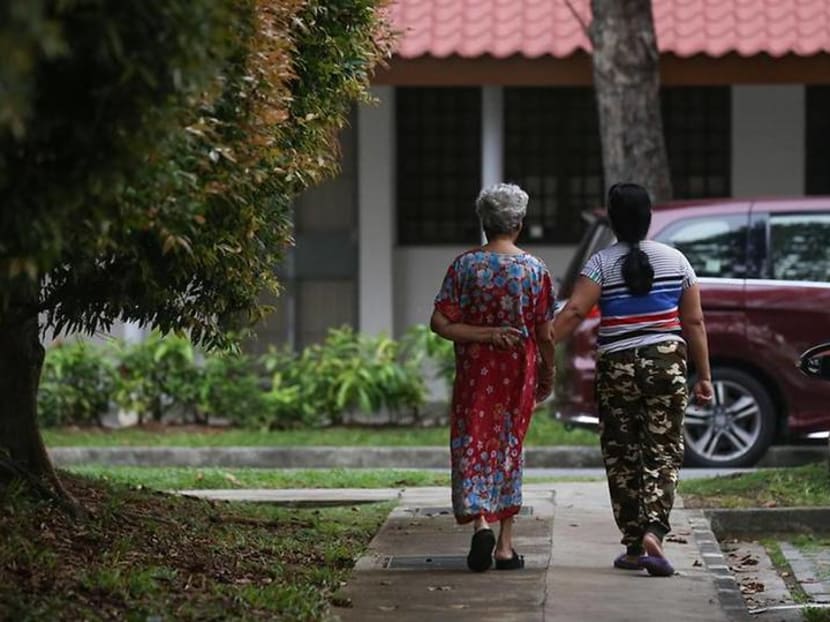Commentary: Can new part-time cleaning services replace Singapore’s need for live-in migrant domestic workers?
Not completely, but it provides more protection and pushes a rethink of how domestic work can be provided, Nanyang Technological University’s Ye Junjia says.

A foreign domestic helper is seen strolling with an elderly woman on Oct 31, 2019. (File photo: TODAY/Najeer Yusof)
SINGAPORE: Both employers and domestic workers, current or prospective, should sit up and take notice of the now-permanent Household Services Scheme (HSS).
Households can engage part-time household services from 76 companies approved under the scheme, provided by female migrant workers deployed to multiple homes on an on-demand basis.
It is an expansion of a pilot put in place since 2017 by the Ministry of Manpower (MOM) as an alternative model to full-time live-in migrant domestic workers (MDWs). According to the MOM, more than 10,000 households currently tap on such household cleaning services.
Strict border controls due to the COVID-19 pandemic have impacted the global mobility of labour. One deeply felt in the daily lives of Singapore families has been the tightened supply of MDWs.
This shortage should push us to ask how we can balance our labour needs with just and fair treatment of those who fulfill them. It is an opportunity for greater labour equity for essential work that has long been undervalued.
And the on-demand, part-time services model may help us make progress by shifting the dominant ways in which we currently think about, organise and enforce rules around the provision of migrant domestic work.
A RELIEF FOR EMPLOYERS?
The HSS may come as a relief for households feeling the strain of bringing in new or returning MDWs, after more than a year of continually changing COVID-19 restrictions.
As many MDWs hail from higher-risk countries, employers have faced successive difficulties, from halted or controlled entry approvals and repeated deferrals of entry dates, to bearing the cost of isolation, testing, medical insurance and treatment.
According to employment agencies, the cost of hiring someone from the Philippines has increased to about S$4,000, up from S$2,400 pre-COVID.
With the Association of Employment Agencies (Singapore)’s new pilot to bring in more workers safely, employers will have to budget another S$1,500 to S$2,000 for additional isolation and testing in MDWs’ home countries.
Employers looking at transfer helpers to avoid the costs of hiring from overseas will find themselves in a similarly tight situation, due to the limited supply and strong demand for transfer workers.
Households may alleviate their load by parceling out specific ad-hoc services to HSS companies with a ready pool of workers already in Singapore, instead of navigating these hurdles to hire full-time live-in help.
This is also an attractive alternative for those hesitant about the perceived intrusiveness of having a non-family member living under the same roof.
STRONGER PROTECTION, LOWER CHANCE OF ABUSE
MDWs will also be watching closely if they are eligible to stay in Singapore and join HSS companies after their contracts end.
High-profile news of abuse at the hands of employers, notably Piang Ngaih Don, have spooked the community despite more measures to detect abuse and support MDWs’ well-being. Prospective workers may also think twice about taking on MDW jobs and potentially putting themselves in vulnerable positions, further limiting the manpower supply.
The HSS model addresses some of these pressing concerns by changing living arrangements of workers and spatially separating time at work and outside work.
Workers live outside the homes of people who need their services, in accommodation provided by their companies. It takes away the closed home environment where overwork and abuse can be harder to detect, two common grievances reported by the Humanitarian Organisation of Migration Economics (HOME).
Another stark difference is that workers under HSS companies are protected under the Employment Act, which mandates maximum working hours, overtime pay, and certain leave entitlements, compared to the ambiguous language in regulations that govern MDWs.
The defined scope of HSS services can also help address informal excesses, such as deploying the MDWs outside of the employer’s home.
Domestic workers will likely be keen to re-balance the relationship as one between a provider and a consumer of valued services, instead of perceived ownership. In the long run, stronger protections and reduced vulnerability may increase the attractiveness of live-out domestic work as an employment prospect.
A COMPLETE SHIFT UNLIKELY
HSS is far from a perfect replacement for MDWs. A complete shift away from live-in domestic workers remains unlikely as families may require diverse services that do not fit an on-demand, part-time model.
Those who require round-the-clock caregiving services for seniors, very young children, or household members with special needs, already face difficulties of securing live-in domestic workers.
However, hiring live-in MDWs who may not always be appropriately trained is not a sustainable solution in the longer term.
As our population ages, such needs require more comprehensive and affordable forms of caregiving services that households can access, especially those from lower or lower-middle income groups. Domestic service should be considered and developed within this wider economy of caregiving.
Moving towards a blended model of both part-time and live-in domestic workers may not necessarily mean greater equity for workers either.
Case studies emerging out of South Africa, India and the United States remind us that existing inequalities and power differentials tend to be reinforced in models of on-demand domestic labour provision.
Other concerns about the working and living conditions for domestic workers will require continued monitoring by MOM and the industry, including ensuring that employers provide safe and hygienic accommodation, the fair distribution of work amongst the women, job security and workplace health and safety protections.
But having such conversations signal a hopeful improvement to the situation of domestic workers, compared to the opaque treatment of MDWs today.
What if a domestic worker is okay with doing extra work for a fee? Experts break down what's fine and what's not:
RETHINKING HOW DOMESTIC WORK IS PROVIDED
Domestic work is precarious work carried out by marginalised women often excluded from labour protection frameworks.
Policy-makers and companies facilitating and providing part-time domestic labour should play a central role in enforcing regulations to ensure equity for workers in the long term.
Given the current borders controls, this is an opportune time to rethink how domestic work can be provided and valued.
Many may argue that new measures to be implemented in 2021 and 2022, including the mandatory rest day each month that cannot be compensated away, enhanced medical examinations to pick up signs of abuse and post-placement checks by employment agency, are long overdue.
They are, nevertheless, a step in the right direction towards addressing the well-being of migrant domestic workers in Singapore.
About one in five households hire a live-in MDW. As workforce participation rates increase, alongside a rapidly ageing population, Singapore’s dependence on domestic workers looks set to increase further.
The next major steps would be the enforcement of protections for domestic workers, both live-in and part-time, whose labour we cannot do without.
Ye Junjia is an Assistant Professor at the School of Social Sciences, Nanyang Technological University.









